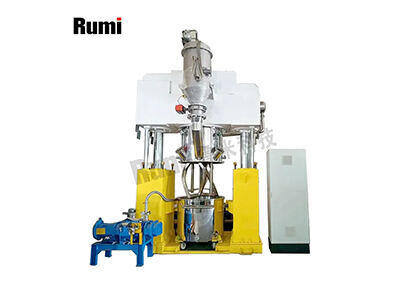Uncover the Diverse Industrial Applications
The industrial world depends extensively on high viscosity mixers for its diverse operations. High viscous materials find exceptional use in industrial applications because of their capability to mix thick materials in food processing as well as pharmaceuticals. Some important sectors benefit immensely from high viscosity mixers.
Pharmaceuticals
The pharmaceutical sector uses high viscosity mixers to unite active pharmaceutical elements with carriers for manufacturing ointments creams and gels. The distribution quality of compounds depends on these mixers to perform homogeneously and this makes the end product work more effectively. These mixers enable consistent homogeneous textures that enhance product stability while making users more comfortable when applying the products.
Cosmetics
Lotions creams and gels production within the cosmetics industry depends completely on high viscosity mixers. These mixers create homogeneous mixtures between diverse oils and emulsifiers and active ingredients to produce products with smooth attractive appearance. Product satisfaction depends on mixers to attain the appropriate viscosity and texture.
Chemicals and Adhesives
The blending of polymers and resins and adhesives often uses high viscosity mixers which operate within the chemical and adhesive industry. The substances exhibit high viscosities requiring specialized mixing solutions to obtain a well-blended mixture. The chemical reaction processes in high viscosity mixers execute evenly throughout the mixture which produces products that deliver effective results consistently.
Paints and Coatings
The production process of paints and coatings depends on high viscosity mixers as a fundamental element. The successful production of these products depends on the exact blending of pigments binders with solvents before they reach their final application state. Consistent mixing depends on the mixers because uniform consistency enables quality control and helps attain desired finish quality and coverage results in each production batch.
Explore Their Function in Material Processing
The operational principles of high viscosity mixers include specific mechanisms created to process materials that are thick and adhesive. This section details how mixers function as well as describing their critical components used in material processing operations.
Mechanisms of Function
High viscosity mixers make use of durable components that guarantee efficient mixing of thick materials due to their differences from standard mixers. High viscosity mixers operate with strong motors while utilizing special blades or paddles that perform several mixing stages. The machine completes several mixing stages that blend ingredients completely while stopping formation of clumps and other inconsistencies.
Mixing Techniques
Several mixing methods are available for high viscosity mixers among which are dispersive mixing followed by distributive mixing along with reactive mixing. Dispersive mixing requires processing agglomerates to achieve smaller dispersal of their constituents. These particles achieve uniform distribution in the mixture through the usage of distributive mixing. Reactive mixing enables chemical component reactions which occurs during the blending process.
Components and Build
Build quality together with design elements represent essential factors that affect performance in high viscosity mixers. High-grade stainless steel along with other durable materials constitute typical mixer construction because they endure demanding mixing situations without showing any degradation. Professional mixers combine temperature-controlled jacketed bowls with their components to preserve the properties of materials while processing.
Adaptability in Processing
High viscosity mixers transform to suit different processing requirements depending on industry demands. The machines come with variable speed drives which give operators full control for mixing speed adjustments based on material characteristics. Some mixers allow users to pick and change blades and paddles which improve effectiveness when working with different types of high viscosity substances.
Ensuring Homogeneity
The principal operational task of high viscosity mixers involves achieving uniformity of outcomes. The mixing equipment develops powerful shear actions that successfully blends all mixture components together. The quality and operational performance of products depend heavily on maintaining consistency in both texture and composition in specific manufacturing sectors.
Safety and Efficiency
The manufacturing process of high viscosity mixers represents both safety excellence and operational efficiency standards. High viscosity mixers possess three essential safety features together with easy-to-use interface and overload security systems and self-triggering safety shutdowns. The device features embedded safety components that both defend operators from risks and boost operational efficiency and production volumes.
High viscosity mixers serve multiple industrial applications through their effective handling capability regarding thick and dense products. All industrial sectors depend upon these mixers for their processing requirements due to their critical value. The knowledge of their wide-ranging characteristics and tasks explains their suitability for demanding operational requirements demanding precision along with consistency and secure performance.
 EN
EN
 AR
AR
 BG
BG
 HR
HR
 CS
CS
 DA
DA
 NL
NL
 FI
FI
 FR
FR
 DE
DE
 EL
EL
 IT
IT
 JA
JA
 KO
KO
 NO
NO
 PL
PL
 PT
PT
 RO
RO
 RU
RU
 ES
ES
 SV
SV
 TL
TL
 ID
ID
 LT
LT
 SR
SR
 SK
SK
 SL
SL
 VI
VI
 HU
HU
 TH
TH
 TR
TR
 FA
FA
 MS
MS
 BE
BE
 IS
IS
 AZ
AZ
 BN
BN
 EO
EO
 LA
LA
 MN
MN



